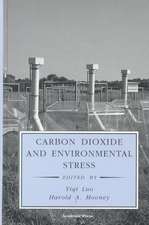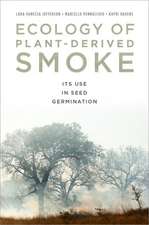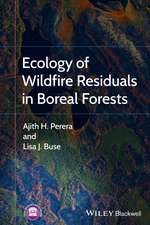Plant Disturbance Ecology: The Process and the Response
Editat de Edward A. Johnson, Kiyoko Miyanishien Limba Engleză Hardback – 29 apr 2007
- Includes coverage on six different disturbance processes: Wind, Gravity, Geomorphic, Hydrologic, Combustion, and Biotic
- Provides a clear explanation of how some of the physical processes of disturbance affect plant ecological processes
- Offers ecologists an up-to-date understanding of the physical processes and allows them to predict future affects of disturbances
- Unites two related fields by linking the disturbance processes and ecological responses
- Presents physical scientists with ideas of how they might usefully apply their knowledge to advance understanding of ecological systems
Toate formatele și edițiile
| Toate formatele și edițiile | Preț | Express |
|---|---|---|
| Paperback (1) | 692.65 lei 5-7 săpt. | |
| ELSEVIER SCIENCE – 20 oct 2020 | 692.65 lei 5-7 săpt. | |
| Hardback (1) | 551.41 lei 6-8 săpt. | |
| ELSEVIER SCIENCE – 29 apr 2007 | 551.41 lei 6-8 săpt. |
Preț: 551.41 lei
Preț vechi: 716.11 lei
-23% Nou
Puncte Express: 827
Preț estimativ în valută:
105.52€ • 112.83$ • 87.97£
105.52€ • 112.83$ • 87.97£
Carte tipărită la comandă
Livrare economică 17 aprilie-01 mai
Preluare comenzi: 021 569.72.76
Specificații
ISBN-13: 9780120887781
ISBN-10: 0120887789
Pagini: 720
Ilustrații: Approx. 180 illustrations
Dimensiuni: 152 x 229 x 46 mm
Greutate: 1.11 kg
Editura: ELSEVIER SCIENCE
ISBN-10: 0120887789
Pagini: 720
Ilustrații: Approx. 180 illustrations
Dimensiuni: 152 x 229 x 46 mm
Greutate: 1.11 kg
Editura: ELSEVIER SCIENCE
Public țintă
Professionals, researchers and students interested in vegetation dynamics and plant community ecology. Likely those in biology, botany, and ecology departments.Cuprins
Introduction
Disturbance and Succession
Wind Processes
The turbulent wind in plant and forest canopies; Microbursts and macrobursts: windstorms and blowdowns; Understanding how the interaction of wind and trees results in windthrow, stem breakage and canopy gap formation.
Gravity Processes
Meteorological conditions associated with ice storm damage to forests; The effect of icing events on the death and regeneration of North American trees
Geomorphic Processes
Disturbance processes and dynamics in coastal dunes; Coastal dune succession and the reality of dune processes; Fluvial geomorphic disturbances and life history traits of riparian tree species
Hydrologic Processes
Water level changes in ponds and lakes: the hydrological processes; Vegetation dynamics due to fluctuating water levels in prairie wetlands
Combustion Processes
Modeling heating effects; Fire effects on grass populations; Wildfire as a distributed tree population process
Biotic Processes
Insect defoliators as periodic disturbances in northern forest ecosystems; Modelling disturbance and recovery of lodgepole forest due to mountain pine beetle outbreaks on landscape scales; Relationship between spruce budworm outbreaks and forest dynamics in eastern North America; Impact of beaver foraging on structure of boreal forests; Beaver, willow shrubs and floods
Disturbance and Succession
Wind Processes
The turbulent wind in plant and forest canopies; Microbursts and macrobursts: windstorms and blowdowns; Understanding how the interaction of wind and trees results in windthrow, stem breakage and canopy gap formation.
Gravity Processes
Meteorological conditions associated with ice storm damage to forests; The effect of icing events on the death and regeneration of North American trees
Geomorphic Processes
Disturbance processes and dynamics in coastal dunes; Coastal dune succession and the reality of dune processes; Fluvial geomorphic disturbances and life history traits of riparian tree species
Hydrologic Processes
Water level changes in ponds and lakes: the hydrological processes; Vegetation dynamics due to fluctuating water levels in prairie wetlands
Combustion Processes
Modeling heating effects; Fire effects on grass populations; Wildfire as a distributed tree population process
Biotic Processes
Insect defoliators as periodic disturbances in northern forest ecosystems; Modelling disturbance and recovery of lodgepole forest due to mountain pine beetle outbreaks on landscape scales; Relationship between spruce budworm outbreaks and forest dynamics in eastern North America; Impact of beaver foraging on structure of boreal forests; Beaver, willow shrubs and floods
Recenzii
"The process by which vegetation changes over time has fascinated plant ecologists for at least a century. Early theories emphasized slow, steady change to a hypothetical stable 'climax' community. By the 1970s, ecologists began to realize that disturbance was the rule, not the exception, and a rather radical shift in thinking about vegetation took hold. This multidisciplinary compendium seeks to move what might be called disturbance science beyond descriptive approaches to look at how particular physical disturbances actually cause particular ecological effects. The many authors cover, e.g., the specifics of how forces like wind (turbulence, microbursts, etc.) can physically cause stem breakage in trees. Other modes of disturbance treated here include ice storm damage to forests and trees; dynamic processes that affect coastal dunes; fluvial processes related to riparian tree growth; the effects of water-level changes in ponds and lakes; heating effects on vegetation; fire's effects on grasslands and trees; a variety of insect impacts on different systems; and the impact of beavers on woody vegetation. The level of technical detail in the chapters varies greatly, and a few rely heavily on mathematical formulas. Other chapters are essentially literature reviews. Plant ecologists with a process- or mechanistically oriented approach to understanding vegetation change will appreciate this book. Summing Up: Recommended. Upper-level undergraduates and above." --CHOICE

















